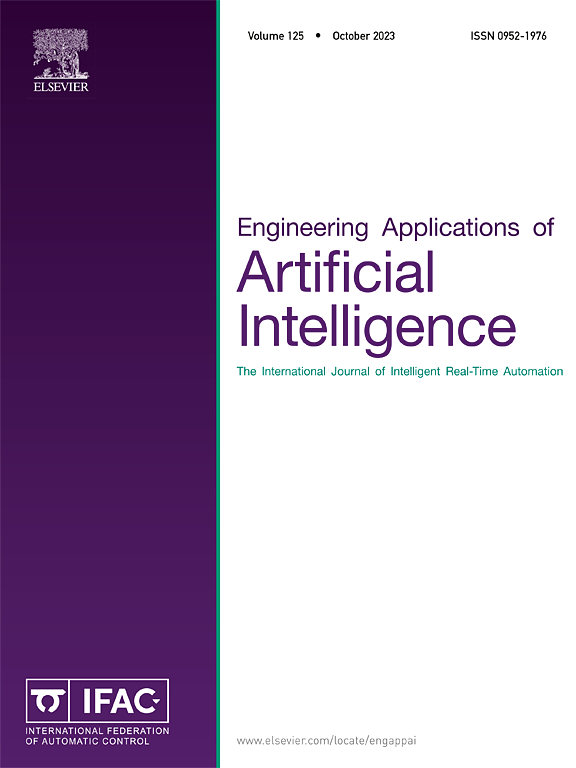运用卷积注意机制和人类记忆搜索进行有效的英语-乌尔都语翻译
IF 7.5
2区 计算机科学
Q1 AUTOMATION & CONTROL SYSTEMS
Engineering Applications of Artificial Intelligence
Pub Date : 2025-05-19
DOI:10.1016/j.engappai.2025.111043
引用次数: 0
摘要
近几十年来,机器翻译已成为一个突出的研究领域,其主要目的是克服语言障碍。早期的方法主要集中在源语言和目标语言之间的逐字翻译。然而,在人工智能(AI)、通信和计算技术进步的推动下,数据驱动模型(如神经机器翻译和统计方法)已经出现了转变。本文提出了一种基于卷积注意机制的人类记忆搜索(CAM-HMS)算法,用于英语到乌尔都语的翻译,以实现高质量、高效的机器翻译。该模型包括预处理、句子填充、词嵌入、编码、解码和目标文本生成等几个关键阶段。为了提高神经网络机器翻译的翻译效率,本文还引入了一种新的基于蜘蛛的搜索策略。使用UMC005英语-乌尔都语数据集(英语并行语料库)对性能进行评估。乌尔都语,以及罗马乌尔都语到英语的翻译数据集。采用双语评估代理(BLEU)、美国国家标准与技术研究院(NIST)、单词错误率(WER)、准确率(Accuracy)、精密度(Precision)、召回率(Recall)和F-Measure等各种自动评估指标来评估模型的效率,并将其输出与谷歌Translate进行比较。该模型的BLEU平均分为82.14%,NIST平均分为79.51%,WER平均分为2.77%,准确率为98.99%,精密度为98.95%,召回率为98.90%,F-Measure平均分为98.92%,表明该模型能够产生高质量的机器翻译结果。本文章由计算机程序翻译,如有差异,请以英文原文为准。
Applying convolutional attention mechanisms and Human Memory Search for effective English-Urdu translation
In recent decades, machine translation has become a prominent area of research, with the primary objective of overcoming language barriers. Early approaches primarily centered on word-for-word translation between source and target languages. However, there has been a shift towards data-driven models, such as neural machine translation and statistical methods, driven by advancements in Artificial Intelligence (AI), communication and computing technologies. This paper introduces a novel Convolutional Attention Mechanism-based Human Memory Search (CAM-HMS) algorithm for translating English into Urdu, to achieve high-quality and effective machine translation. The proposed model consists of several key phases, including pre-processing, sentence padding, word embedding, encoding, decoding, and target text generation. A new spider web-based search strategy is also incorporated to enhance the translation process in neural machine translation. The performance is evaluated using a UMC005 English-Urdu dataset, Parallel corpus for English & Urdu language, and the Roman Urdu to English Translation Dataset. Various automatic evaluation metrics such as the Bilingual Evaluation Understudy (BLEU), National Institute of Standards and Technology (NIST), Word Error Rate (WER), Accuracy, Precision, Recall, and F-Measure are used to assess the model's efficiency, and its output is compared to that of Google Translate. The proposed model achieves an average BLEU score of 82.14 %, NIST of 79.51 %, WER of 2.77 %, Accuracy of 98.99 %, Precision of 98.95 %, Recall of 98.90 %, and F-Measure of 98.92 %, demonstrating its effectiveness in producing high-quality machine translation results.
求助全文
通过发布文献求助,成功后即可免费获取论文全文。
去求助
来源期刊

Engineering Applications of Artificial Intelligence
工程技术-工程:电子与电气
CiteScore
9.60
自引率
10.00%
发文量
505
审稿时长
68 days
期刊介绍:
Artificial Intelligence (AI) is pivotal in driving the fourth industrial revolution, witnessing remarkable advancements across various machine learning methodologies. AI techniques have become indispensable tools for practicing engineers, enabling them to tackle previously insurmountable challenges. Engineering Applications of Artificial Intelligence serves as a global platform for the swift dissemination of research elucidating the practical application of AI methods across all engineering disciplines. Submitted papers are expected to present novel aspects of AI utilized in real-world engineering applications, validated using publicly available datasets to ensure the replicability of research outcomes. Join us in exploring the transformative potential of AI in engineering.
 求助内容:
求助内容: 应助结果提醒方式:
应助结果提醒方式:


